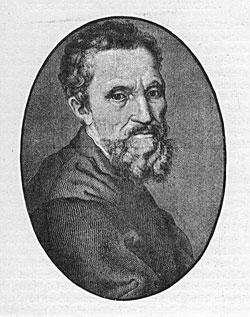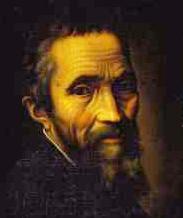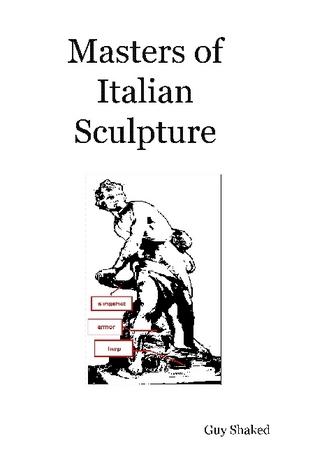
==================================
by Guy Shaked

 God above, seeing the poor state of the art of painting and sculpture and the vanity of
people, sent as a gift to humanity - Michelangelo. This multi talented artist also made
contributions in architecture and poetry.[1]
God above, seeing the poor state of the art of painting and sculpture and the vanity of
people, sent as a gift to humanity - Michelangelo. This multi talented artist also made
contributions in architecture and poetry.[1]
Michelangelo was born on the 6th of March 1475, to (the son of) Ludovico di Leonardo di Buonarotto Simoni. He hid his inclination to painting from his parents at his youth. Yet, when his parents saw that he couldn't be cured from this inclination to painting, sent him to study with Domenico Ghirlandaio when he was 14 years old.[2]
Lorenzo de' Medici wanted sculptors for his garden of ancient sculptures, and asked Ghirlandai to send young sculptors to be taught in his garden in their art. Among others was chosen Michelangelo [3].
Lorenzo became inspired by Michelangelo works and was in anticipation for them. Then he asked Michelangelo's father for his son to live with his family as if he were one of his sons. Michelangelo remained there for 4 years until the death of Lorenzo in 1492 [4].
[p.421] After the death of Lorenzo, Michelangelo returned to his father's house and made there Hercules.[p.422] For the Church of Santo Spirito, Michelangelo carved at those years the Wooden Crucifix. He used to dissect bodies in order to study anatomy.
Because of political turmoil under Piero de'Medici Michelangelo left to Venice and Bologna. In Bologna he stayed over a year at the house of Giovan Francesco Aldovrandi. There he added figures to a tomb at Aldrovandi's request.
[p. 423] Michelangelo returned to Florence and carved a small figure of Saint John in marble for Lorenzo di Pierfrancesco de'Medici. He also made then a life size sleeping Cupid.
Michelangelo left for Rome and served there for almost a year Cardinal San Giorgio. [p.424] There he created a cartoon of Saint Francis for a painter (and barber) at the service of the Cardinal. For another Roman gentleman, Messer Jacopo Galli he careved a life-size Cupid and Bacchus. Afterwards, for the French Cardinal Rouen he made a Pieta which was placed in Saint Peter's. [p.425] Michelangelo left his name on it. [p.426] Some said he made Maria too young in it.
Michelangelo returned to Florence and [p.427] obtained a large block of marble from which he made the David which was erected in 1504. [p.428] He then cast in bronze another David, for Soderini which the later sent to France.
He made at that time two marble tondos he left unfinished. One of them was for Taddeo Taddei and another for Bartolomo Pitti. [p.429] He also made then another unfinished statue of Saint Matthew for Santa Maria del Fiore and a bronze tondo of Mary for the Flemish merchant of the Moscheroni family. Michelangelo then painted a tondo of Jesus, Mary and Joseph for Angelo Doni.
Soderini commissioned Michelangelo to do a painting for the grand hall of the Council, where Leonardo was also contributing a painting. Michelangelo painted the Pisan war. He made a carton for that, [p.431] which ended torn to parts for other painters to study because of its high esteem.
Michelangelo became famous so that in 1503 the [p.432] new pope Julius II ordered from him his tomb. Michelangelo traveled to Carrara to select the pieces of marble for this project. He finished four statues for this statues. [p.434] He made two prisoners that were given to Signor Roberto Strozzi and sent by him to king Francis. Michelangelo completed a Victory standing over a prisoner which was given by Michelangelo's nephew Lionardo to Duke Cosimo. Michelangelo finished the figure of Moses [p.435] for the tomb of Julius.
But when marble blocks for that mission arrived from Carrara, Michelangelo had to pay for them with his own money and when he went to ask for reimbursement from the Pope he was not let in by the Pope's guards. [p. 436] So Michelangelo left for Florence. Then he went to see the Pope, at the later's request [p. 437] in Bologna. The Pope ordered from Michelangelo a bronze statue of his image which Michelangelo did and it was placed in San Petronio. [p. 438] The body of the statue was later destroyed.
In Rome Bramante and Rephael who were Michelangelo's competitors advised the Pope that when Michelangelo returns from Bologna, [p. 439] he would paint the Sistine Chapel ceiling instead of make the tomb. After an attempt to change the Pope's mind, Michelangelo erected scaffoldings for this job. [p.440] Michelangelo invited painters from Florence to assist him, but was unsatisfied with their work and decided to do it all by himself. [p.442] He completed the chapel in twenty months and [p.443] was paid for it three thousand scudi.
[p.451] After the chapel was finished, Michelangelo returned to work on Julius's tomb, but then Julius died and the next Pope was not interested in continuing this project. The new Pope Leo X ordered Michelangelo to work on the facade of San Lorenzo in Florence, [p.452] but the project took time and was not completed due to the death of Leo X.
Pope Adrian VI seceded him and then Clement VII. [p.453] The later ordered Michelangelo to finish the sacristy and library of San Lorenzo in Florence. In the sacristy, Michelangelo made four tombs. Yet, [p.454] following the expulsion of the Medici from Florence, Michelangelo was made in charge of fortifications of the city. [p.455] During this time he made a painting of Leda for the duke Alfonso I of Ferrara
For the library of San Lorenzo, he made a statue of Mary and the child Christ, yet various parts of the statue were left unfinished. On one of the tombs of the library he put Night and Day and on another Dawn and Dusk. Other statues were of Duke Lorenzo in thought and Duke Giuliano. [p.457] This work was not completed because of the siege and fall of Florence. Then Michelangelo hid until Pope Clement promised that nothing would happen to him.
He then mad an Apollo, but this too was left incomplete. [p.458] In order to finish the library and sacristy of San Lorenzo, some of the work was given to other sculptors. Following, the Pope ordered Michelangelo to paint the last judgment on the Sistine Chapel's wall.[p. 460] Pope Clement died in 1533 and the San Lorenzo library and sacristy remained unfinished. [p.461] Pope Paul seceded him and work on the Last Judgment continued until it was completed and revealed in 1541.
[p.465] In 1546 Antonio di San Gallo died and Michelangelo was appointed as head architect of Saint Peter's. [p.466] He made a new model for Saint Peter's Basilica that replaced that of San Gallo. [p.469] Later, Michelangelo planned a Piazza near Palazzo de'Conservatory, with a statue of Marcus Aurelius on a horse in its middle ( Campidoglio ), that was taken there from the Lateran piazza.
Michelangelo, who was old, became ill with a slow fever and on 17 of February 1563 he died. [p.486] Michelangelo's body was smuggled to Florence and he was buried in the Santa Croce church.
-----------------------------------------------
[*] This essay is based on Giorgio Vasari, Le Vite dei piu' Eccellenti Pittori Scultori e Architetti,Newton, Florence, 1991
[1] Page numbers in brackets are according to: Giorgio Vasari, The lives of the Artists, Julia Conaway Bondanella & Peter Bondanella (trs.), Oxford Uni. Press, New York, 1991
 Read more of Guy's work in the book: Masters of Italian Sculpture
Read more of Guy's work in the book: Masters of Italian Sculpture
Dear visitor, please take a short moment to sign my guest book!
----------------------------------------------------------------

© 2008 Emails are
gladly received: shakedtg@hotmail.com
The Trevi Fountain as the soul in love and the flood that would not drown the church
The Tritone (Triton) fountain as the Glaucus fountain
Other articles by G. Shaked:
ART
BIBLICAL STUDIES
BIOLOGY
CINEMA
LITERATURE
MUSIC
PHILOSOPHY
PHYSICS
(ACOUSTICS)